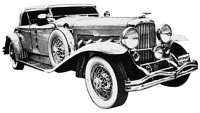
The Biggest Little New and Used Car Showroom in Central New York
 |
Uptown Automotive Hobby Shop The Biggest Little New and Used Car Showroom in Central New York |
I agree, as many do, that 1/25 is the preferred "scale" - though what we commonly use to describe models is not actually scale, but size. "1/25" simply means that a model is 1/25 the actual size...or, 1/25 of the size of the actual vehicle...or, one inch on the model equals twenty five on the actual vehicle. Although 1/25 was long ago determined to be the common size of automotive models, it is actually an odd scale. For example, the size that many of us do not like, 1/24, actually makes more sense. Otherwise known as "half inch scale", it translates to: one inch on the model equals 24 inches on the actual vehicle. Note that it is a nice even number; no fractions or decimals involved. Early Model Kits After WW II most models were made of wood, and were commonly in "1/2 inch scale" (1/24), or "3/4 inch scale" (1/16) [one inch on the model equals sixteen inches on the actual vehicle]; later, in plastic, "3/8 inch scale" (1/32) [one inch on the model equals thirty two inches on the actual vehicle] became popular. The early postwar kits of current and recent automobiles, and (mostly military) trucks were in 1/24 actual size. Models of antique vehicles were in both 3/8" and 3/4" scales. "Promos" Promotional model cars ("promos") were used to promote the sale of new cars, and actually predate model kits (which required assembly) by many years, the first having appeared around 1934.[It should be noted that prior to this, there were pressed steel "toy" replicas of cars and trucks, some of which were very detailed and used by auto manufacturers to advertise the vehicles they sold, as well as being intended as children's playthings.] However, the early promos were made of pot metal, and while painted in colors the actual vehicles were available in, in regard to their size, they were all over the place. AMT, "Official Model Makers To The Industry" For many years AMT (Aluminum Model Toys) touted their status as the "official model makers to the (auto) industry". Ironically, only their first offering, a somewhat generic '47/'48 Ford Fordor, was produced in aluminum; by 1949 plastic became the medium. While others continued to produce promos in pot metal until the mid '50s, AMT and PMC (Product Miniatures Corporation) began the plastic promotional model industry, and 1/25 became the "standard" size. PMC initially offered as great a variety of Chevrolet scale models, as GM offered full size Chevies! A lone offering from Cruver Manufacturing, an exceptional model of the '49 Olds, and in the mid fifties, several offerings from JoHan models all claimed to be 1/25 in size. Long time collectors will have observed that apparently different companies used different slide rules to arrive at the alleged "1/25" size. JoHan was particularly noticeable in varying size, some being smaller than 1/25, while others being larger, yet all listed as 1/25. The Return Of 1/24 In the early 1960s, Monogram Models, a venerable company that had been producing model kits of various subjects, began offering car model kits, first of '30s era Fords, '55 Chevy hardtop and convertible, and later on various muscle cars and street rods in 1/24 actual size. While the subject matter was desirable, the proportions were not always pleasing to the eye. So, given the common acceptance of 1/25 "scale", and the sometimes disappointing appearance of the 1/24 "scale" models, as well as the abundance of subject matter in 1/25, it's understandable why many prefer it. However, sometimes if one likes a specific vehicle, and it is available only in 1/24 - or even a more obscure scale - a modeler will want it regardless, and will make it look great. Again, that "slide rule" thing exists; some times 1/24 and 1/25 parts will interchange, while other times there is a glaring, obvious, noticeable difference. We all have our preferences, and our reasons for those preferences. As we've all heard said: "beauty is in the eye of the beholder".
-Jim Amado, September 2022 page updated 12/22/2023 |